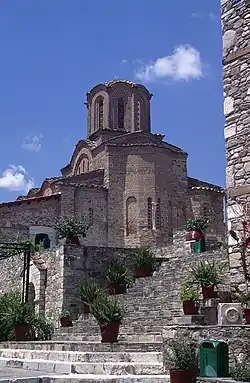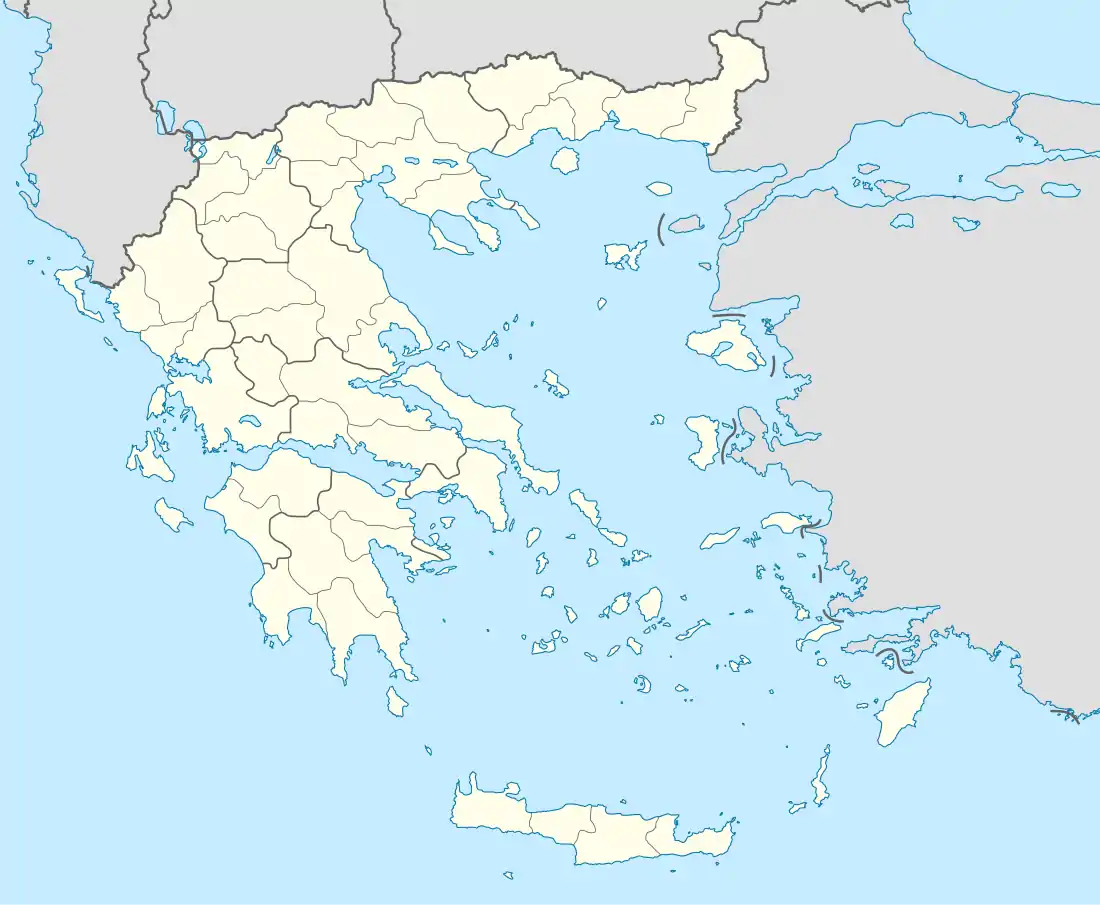Panagia Olympiotissa Monastery
The Panagia Olympiotissa Monastery (Greek: Μονή Παναγίας Ολυμπιώτισσας, lit. 'Panagia of Mount Olympus') is a Greek Orthodox monastery in Elassona, Thessaly, Greece.
Μονή Παναγίας Ολυμπιώτισσας | |
 The katholikon of the monastery | |
 Location within Greece | |
| Monastery information | |
|---|---|
| Established | 1295/1304 |
| Diocese | Metropolis of Elassona |
| People | |
| Founder(s) | Constantine Doukas and Theodore Angelos |
| Architecture | |
| Style | Byzantine architecture |
| Site | |
| Coordinates | 39°53′52.1″N 22°10′59.8″E |
History
The monastery is located on the medieval citadel of the town of Elassona, and was founded between 1295 and 1304,[1][2] probably by the co-rulers of Thessaly, the sebastokratores Constantine and Theodore.[3]
Only the main church (katholikon) survives from the original monastery complex. It comprises a domed main space with an ambulatory on three sides.[1][2] Its masonry is brick-enclosed, and features use of ancient spolia.[3] Various annexes were added at times to the katholikon, but none of them survives today, apart from a small chapel in the southern side, built in 1819 and dedicated to Saint Nektarios.[3]
The 14th-century frescoes that decorate its interior make it "one of the finest examples of Palaiologan-era architecture and painting".[1] Among the frescoes is a portrait of the Byzantine emperor Andronikos II Palaiologos (r. 1282–1328).[1] The wooden templon dates to 1840, was constructed by the master carver Demetrios of Metsovo.[3]
In a 1342 sigillion of Patriarch John XIV Kalekas, the stauropegic status of the monastery is confirmed.[2] A forged chrysobull attributed to Andronikos III Palaiologos concerning the possessions of the monastery contains extensive estates and subsidiary establishments (metochia) as far as Larissa.[2] The monastery amassed great wealth, and was the major spiritual centre of the region, particularly during the 16th and 18th centuries.[3]
Today
Dedicated to the Dormition of the Theotokos, until the 18th century it is recorded also as dedicated to the Transfiguration of the Saviour.[3] The surname Olympiotissa derives from a famed icon of the Panagia, which is believed to have come from a no longer extant monastery at Karya, on the foot of Mount Olympus. Once a year, on 5 October, the icon is borne in a litany from the monastery to the Church of Saint Demetrios.[3]
Originally male, today it is a female monastery, and celebrates on 6 and 15 August.[3] The monastery also features a guest house, library, and a natural history museum.[3]
References
- "Η Μονή της Παναγίας Ολυμπιώτισσας στην Ελασσόνα" (in Greek). Larissa Ephorate of Antiquities. Retrieved 10 November 2018.
- Koder, Johannes; Hild, Friedrich (1976). Tabula Imperii Byzantini, Band 1: Hellas und Thessalia (in German). Vienna: Verlag der Österreichischen Akademie der Wissenschaften. p. 153. ISBN 978-3-7001-0182-6.
- "Ιερά Μονή Παναγίας Ολυμπιωτίσσης" (in Greek). Archbishopric of Athens. Retrieved 17 November 2018.
Further reading
- Constantinides, Efthalia C. (1992). The Wall Paintings of the Panagia Olympiotissa at Elasson in Northern Thessaly. Athens: Canadian Archaeological Institute at Athens.